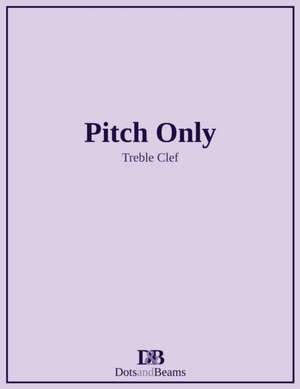Pitch Only - Treble Clef
Autor Nathan Petitpasen Limba Engleză Paperback – 18 mar 2020
The aim with this book is to allow the user to focus specifically on exercises centred around pitch without the distraction of rhythmic values or time signatures. This can begin with the practice of sight-reading but can expand to include many other learning goals.
The diatonic sets contain notes with no accidentals or key signature. These collections can be read as written, using only natural notes, or in any of the 15 key signatures from 7 flats to 7 sharps.
Chromatic collections include sharp and flat notes as well as natural ones. The later exercises in these chapters increase the difficulty by including B#, Cb, E#, and Fb.
Ledger line chapters start with the first ledger line and gradually expand away from the staff. Exercises above the staff reach up to the space above the fifth ledger line while exercises below reach down to the space below the third.
The random nature of the notes in these exercises is intentional; it forces the user to pay attention to each note and makes the exercises very difficult to memorize, ensuring that they will still present a challenge even after multiple readings.
It's important when sight-reading to cycle through the exercises quickly rather than dwelling on a single exercise for a long time. This will ensure that you're strengthening your ability to read the notes rather than just memorizing the exercises.
Some suggestions for how to use this book include:
Gain comfort reading the notes and finding them on your instrument in no particular rhythm or tempo. A greater challenge can be achieved by playing them at a steady tempo or by playing them in a simple rhythmic pattern. Beginner students can begin by writing in the note names.
Play each exercise in all 15 key signatures.
Advanced theory students and improvising musicians can also use these exercises to practice identifying scale degrees in various keys or playing chords built on every scale degree in the chosen key.
Develop comfort with chords by playing a chord built on each note in the exercise. For example: for each note in the exercise, play the major chord with that root. Increase the difficulty with different chord qualities or different chord tones, for example: for every note, play the minor 7th chord in which the given note is the 3rd.
Practice transposing into different keys. This is an especially useful challenge for people who play transposing instruments such as brass and woodwind instruments.
Chapters with wide ranges can present a great exercise for musicians who play instruments where large leaps are a challenge. People who play strings, mallet percussion, piano, woodwinds, and brass would be among those who would benefit from practising these awkward leaps and falls.
As with any of the Dots and Beams books, the uses for this particular collection are limited only by the imagination of the musician using it. I highly encourage anybody using this book to find as many uses for it as possible.
Preț: 90.11 lei
Nou
Puncte Express: 135
Preț estimativ în valută:
17.25€ • 17.94$ • 14.45£
17.25€ • 17.94$ • 14.45£
Carte disponibilă
Livrare economică 21 februarie-07 martie
Preluare comenzi: 021 569.72.76
Specificații
ISBN-13: 9781999291327
ISBN-10: 1999291328
Pagini: 128
Dimensiuni: 216 x 280 x 8 mm
Greutate: 0.31 kg
Editura: Dots and Beams
ISBN-10: 1999291328
Pagini: 128
Dimensiuni: 216 x 280 x 8 mm
Greutate: 0.31 kg
Editura: Dots and Beams
